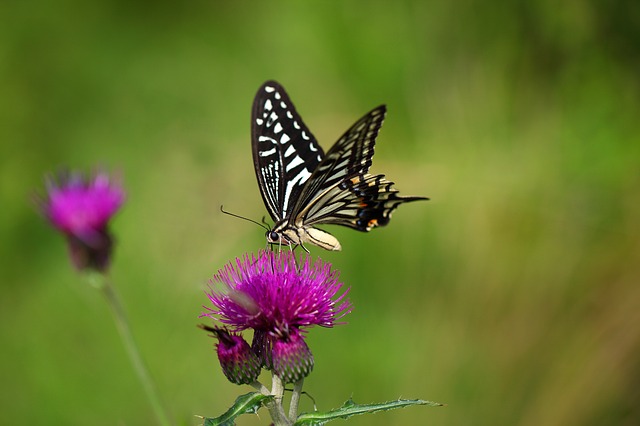 |  |  |   |  |
 |
Thistles are perennial plants, 60-150 cm tall, rarely up to 200 cm, it is weakly prickly, with a short and thick root. The stem is thick, erect, not covered with spikes. The leaves are arranged alternately, weakly prickly, large (10-40 cm in length and 8-18 cm in width), green on the upper side, gray on the underside from dense hair, the lower leaves on the petioles, the middle and upper ones - sessile, covering the stem, lanceolate in shape.
Upper and lower leaves entire, finely toothed, middle deeply cleft or divided into narrow lobes; the edges of the leaves and their parts are covered with fine spines. The flowers are small, tubular, purple, collected in large (3-5 cm diameter), solitary baskets, which are located at the ends of the stems and are covered with thorns or thistles.
The fruit is a seed! Blooms in June-September.
Note:
Before thistles begin to bloom, they tend to be similar to each other. For example,
cabbage Thistle
(Cirsium oleraceum L.) does not have gray hairs on the leaves, contrasting colors and leaf slits, like the
melancholy
thistle (Cirsium heterophyllum L.). Later, the flowers are also different: the multi-leaved thistle is purple, but the thistle is pale, green-yellow. I mention this because these plants are often not recognized among themselves.
The above-ground part and roots of thistle are used for medicinal purposes. The above-ground part of the plant is harvested at the moment it blooms. The root is dug in autumn, washed well and dried in a well-ventilated and shaded place or in forced dryers, not exceeding 50C.
The drug is stored in paper bags for no longer than one year.
The chemical composition of thistle has been little studied, but the following have been found in the plant: essential oil, alkaloids, glycosides, tannins, flavonoids, rubber, anthocyanins, vegetable fats and resins.
There is a lot of ascorbic acid, tannins, essential oil, resins, vegetable fats, flavonoids and glycosides are also found in the ice plant.
Medicinal significance
Thistle has anti-inflammatory, antispasmodic, emollient, vasodilating, bleeding-stopping and wound-healing properties.
Thistles of the species mentioned in this article are used in folk medicine, although there are significantly more of them in the nature of Latvia. Scientists use thistle as an anti-bleeding, anti-inflammatory and wound-healing agent. It is used to treat various respiratory diseases, including asthma and pulmonary tuberculosis. Dry thistle powder is used to cover wounds, fresh and crushed thistle is applied to festering wounds and boils. Often, a decoction of thistle roots is also added to bath water to give yourself freshness and reduce sweating.
Thistles
used in folk medicine mainly as an anti-inflammatory and wound-healing agent, as well as an analgesic for pain of various origins. A decoction of the roots of thistle is used to treat toothache, cramps, rheumatism and gout. A decoction of the surface part helps in epilepsy and conjunctivitis (moistened tampons are placed on the eyes). To improve digestion, young leaves and shoots are also used in salads.
